Introduction to the RMS Titanic story
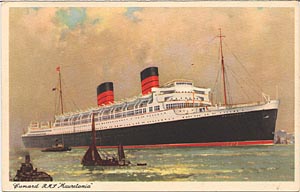
Competition was already beginning with the rival company Cunard Line. They launched two ships, RMS Mauretania and RMS Lusitania.
The Mauretania was launched at the Tyneside shipyard of Swan Hunters and entered service in September 1907. The Lusitania was launched at the John Brown shipyard on the Clyde and entered service in June 1907. Each weighed over 30,000 tonnes. A new generation of ships had been born which out classed the four large White Star Line vessels.
On her second crossing of the Atlantic, the Lusitania took the Atlantic Speed Record for Britain averaging a speed of 23.99 knots, nearly seven knots quicker than the White Star Line ship, RMS Adriatic.
To make matters worse for the White Star Line, the Mauretania also proved to be faster. The Cunard Line had out stripped the White Star Line of owning the fastest and largest ships in the world.
The White Star Line realised that their competitors were winning the struggle to maintain dominance over the Atlantic crossings. They had to react to the situation quickly.
RMS Titanic - The Beginning
In 1899, Joseph Bruce Ismay became Chairman of the White Star Line (WSL) when his father, Thomas Ismay died. In 1907, he became President of the IMM. His long-term goal for his company was to attain the Blue Riband but to do so would require expensive, powerful, but often uncomfortable vessels to achieve the high speed needed.
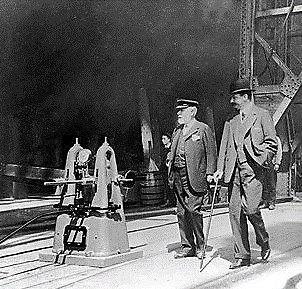
The story of the Titanic began over a dinner in early 1907. Joseph Bruce Ismay, accompanied by his wife went to dine at Downshire House, Belgrave Square in London. They met Lord Pirrie, who had become Chairman of Harland and Wolff Shipbuilders in 1896, and his wife.
The topic of conversation over dinner were the two remarkable new liners: Lusitania and Mauretania. Both were owned by their rival company, the Cunard Line. Ismay raised the concept of bigger and more luxurious ships in order to surpass this competition.
Due to the nature of the industry, Harland and Wolff and the WSL had a close association. Harland and Wolff had constructed all the WSL ships.
After dinner, Ismay and Pirrie discussed the proposed construction of three sister ships: Titanic, Olympic and Gigantic. After the tragic loss of the Titanic, the name Gigantic was changed to Britannic. The Olympic and the Titanic would be nearly one and a half times larger than the Mauretania and the Lusitania. As a result, these three ships made the WSL prominent again in both transatlantic and world liner services.
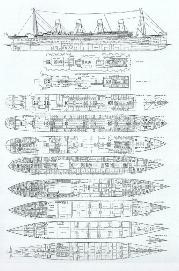 images/titanicplanslarge.jpg
images/titanicplanslarge.jpg
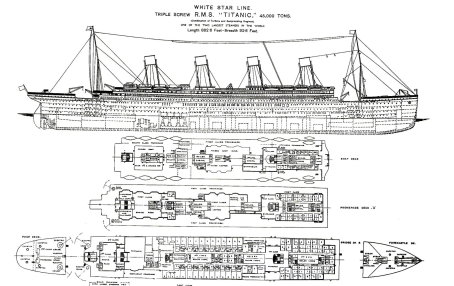 images/titanicplanslarge.jpg
images/titanicplanslarge.jpg
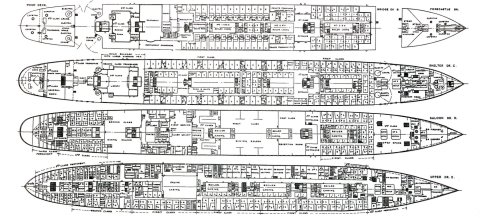 images/titanicplanslarge.jpg
images/titanicplanslarge.jpg
Rough drawings were made of the three ships, which envisaged each with two or three masts. The final plans added a fourth dummy funnel for ventilation but the ships would only have two masts. The chosen names ascribed the three ships as being mighty, powerful: the biggest the world had ever seen. Whilst safety, luxury and comfort were the essential features throughout the plans, all three ships would have to be capable of significant speed.
It was Ismay's job to secure finances. Early in 1908, the WSL issued £2.5 million of additional shares to cover the bulk of the estimated £3 million costs. Together with the profits for the year 1909 exceeding £1 million, it was only a matter of time before the project could start.
By the end of July 1908, the directors of the WSL examined the final designs for the two ships. An agreement with Harland and Wolff was signed on 31 July. It was a historical day for the WSL.
Whilst Ismay and Pirrie had conceived the idea of the three giants, the general responsibility of the design was delegated to Alexander Montgomery Carlisle, General Manager at Harland and Wolff and Lord Pirrie's brother-in-law.
Lord Pirrie approached the shipbuilders John Brown & Co for the supply of steel, and to secure the use of new turbine technologies far more advanced than theirs. The Mauretania had already taken advantage of these new technologies and achieved unsurpassed speeds. The 'Olympic class' ships should average 21 knots.
Construction of RMS Titanic
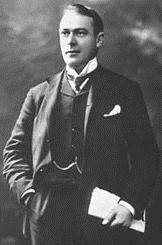
Lord Pirrie's nephew, Thomas Andrews, the distinguished Naval architect, was in charge of design. He was the Managing Director of Harland and Wolff's Design Department. See Titanic Personalities for Thomas Andrews' biography. By 1908, he was at the height of his powers. He prepared the scale drawings that would enable work to start.
Pictured: Thomas Andrews (1873-1912)
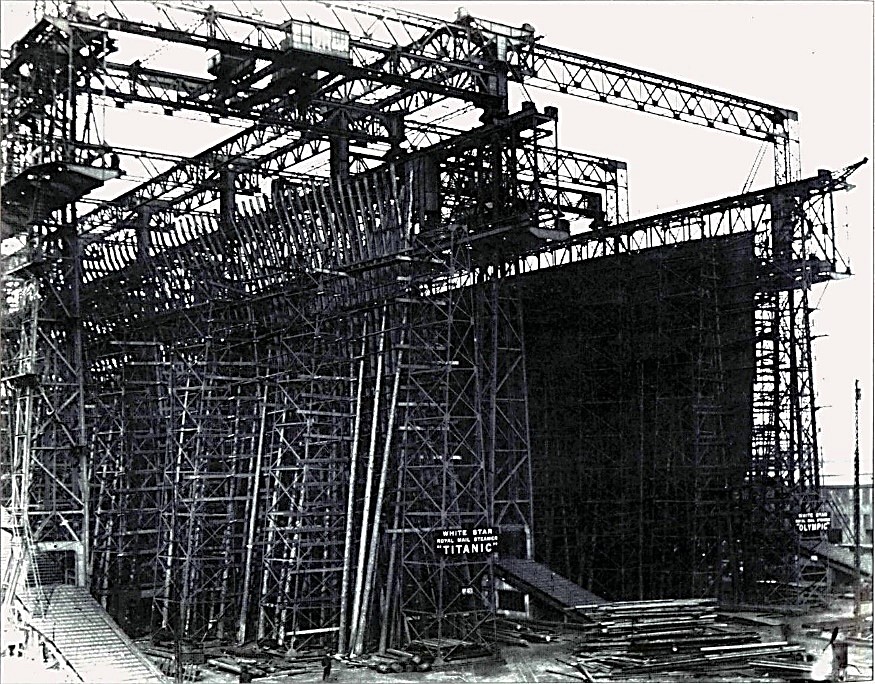
The shipbuilders were faced with the problem of how to build ships of unprecedented size. Since 1853, Harland and Wolff had employed 14,000 workers to build a staggering nine ships at any one time. Even the keels of the larger ships were small compared to the giants they were about to build. No slipways in the world could yet accommodate the Titanic and her sisters.
Construction began on a giant gantry and slipway called the 'Great Gantry' or the 'Arrol Gantry' after its builders, Sir William Arrol & Co, Glasgow. It stood 228 feet high, 270 feet wide and 840 feet long, and weighed more than 6,000 tons. 10 cranes transported men and material to the different levels of construction. The Great Gantry cost £100,000. The crane cost £30,000 and was specially imported from the German Benrather Company to handle the large loads necessary to fit out each ship following its launch.
The Olympic was 882.6 feet long with a beam of 92.6 feet and the Titanic was 882.9 feet long with a beam of 92.6 feet. Each had a gross tonnage of over 45,000. They would be the biggest ships afloat.
On 1 July 1907, the order was given to commence work on two of the sisters. The Olympic was given shipyard number 400 and the Titanic was given 401. The ships would be constructed in the traditional method of keel, frame and shell plating built up of riveted sections. The stern frame had a total complete weight of 70 tons but would be increased by another 73.5 tons once the propeller shafts had been added. The centre anchor weighed 50.5 tons.
The keel of the Olympic was laid on 16 December 1908 and she was framed by 20 November 1908. On 31 March 1909, keel 401, the Titanic, was laid on the adjacent slipway. The Olympic's shell plating was completed by April 1910 and she was launched on 20 October 1910. She was completed by the end of May 1911. The Titanic was launched on 31 May and completed by 2 April 1912.
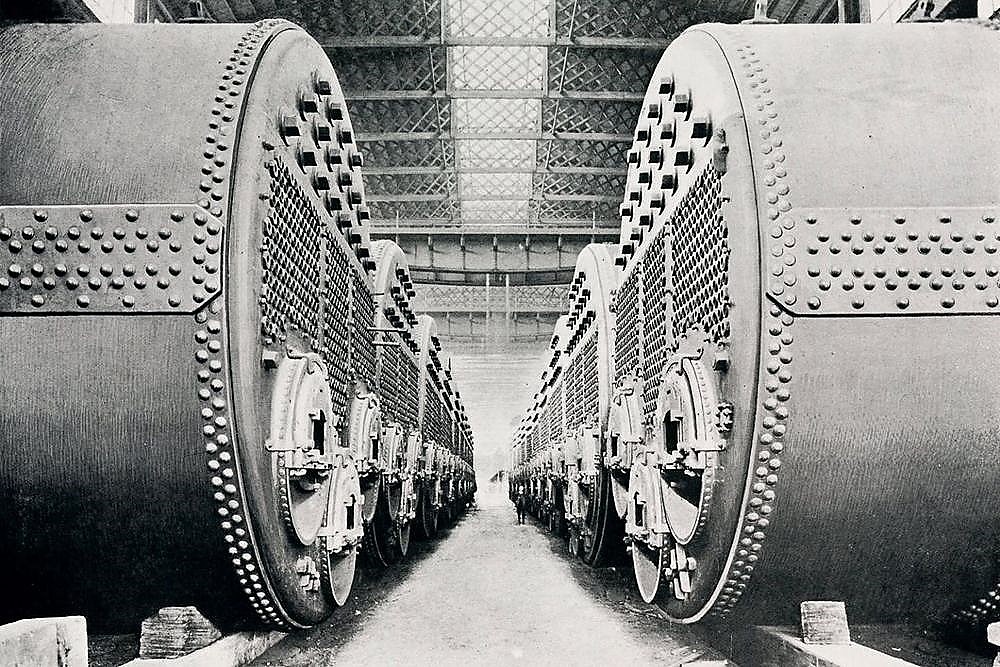
Triple screw engines were needed to propel a 46,000 ton ship. The engines of the 'Olympic class' liners stood four decks high housed in six compartments. In all there were 29 boilers supplied by 159 furnaces generating pressures up to 215lbs per square inch.
As construction of the Titanic and the Olympic continued, it was evident that the ships with an overall length of 882 feet, were too long for the River Test in Southampton. The Southampton Dock Company would have to rebuild one of the wharfs to accommodate the new ships.
As a result, the 'White Star Dock' was designed especially for them. Its construction was completed before the launch of the Olympic. It covered 16 acres and was 40 feet deep at low tide, enabling the ships to be berthed at either low or high tide. See White Star Dock at Southampton.

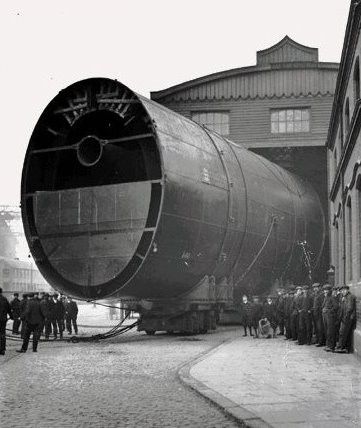
The four funnels were an elliptical shape and were 24 feet 6 inches high by 19 feet long. The fourth funnel was a dummy to provide a balanced appearance.

Above: End view of main engine during construction of RMS Titanic
